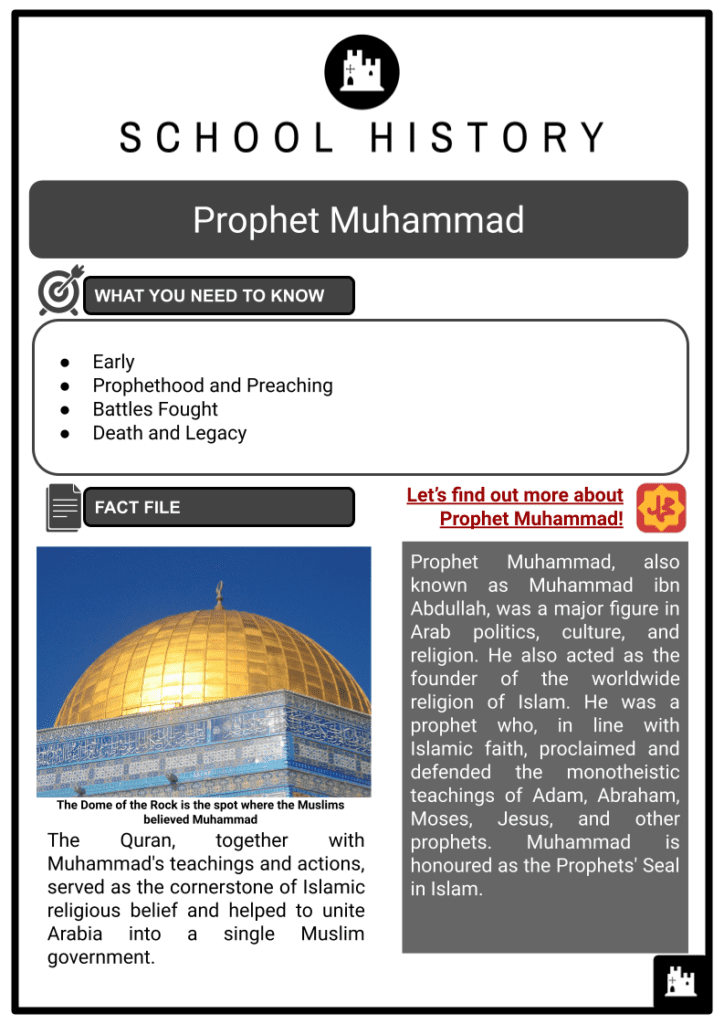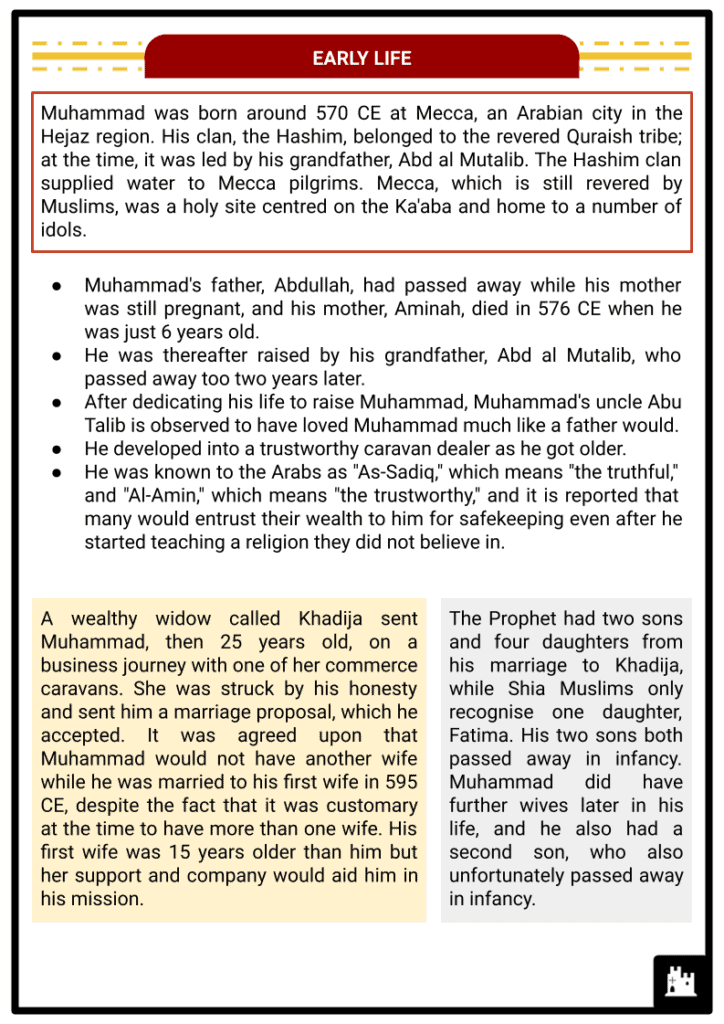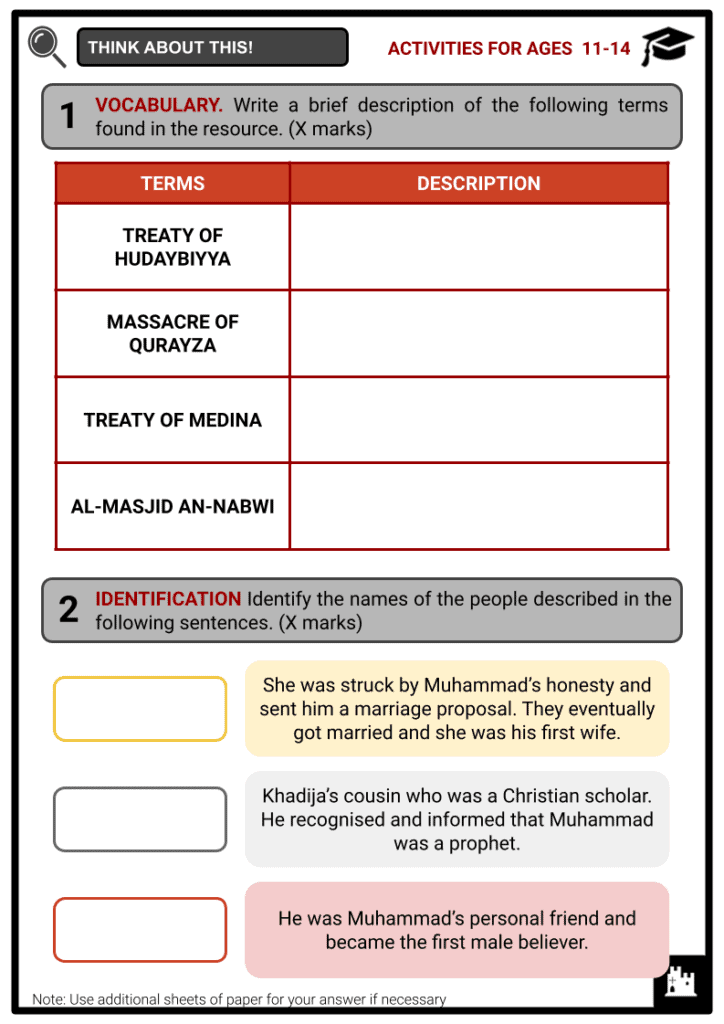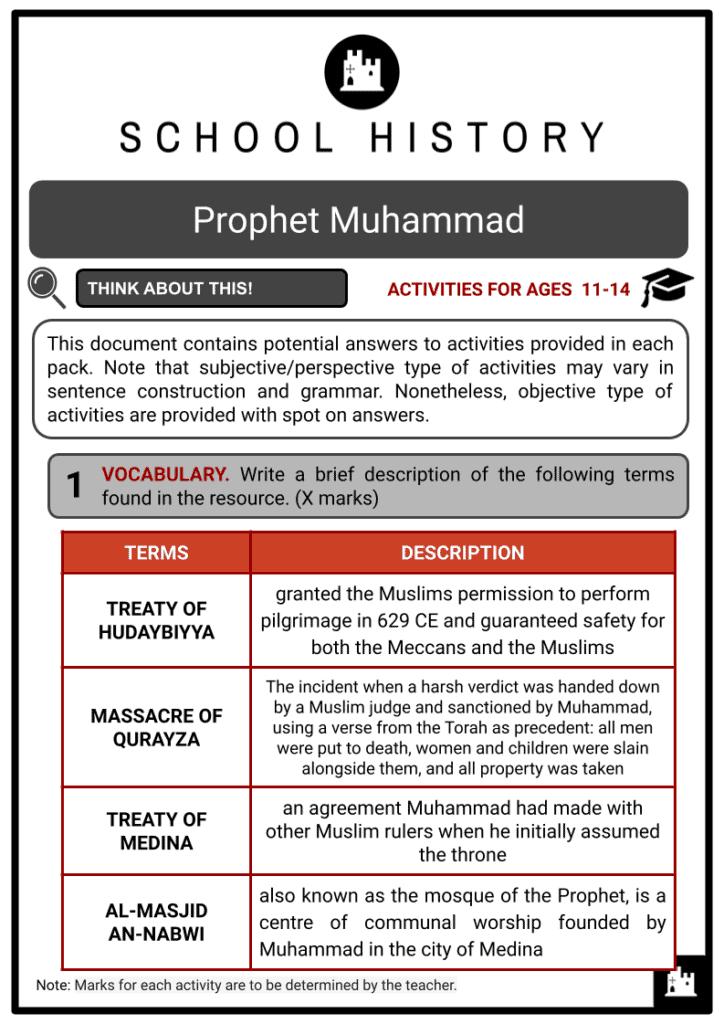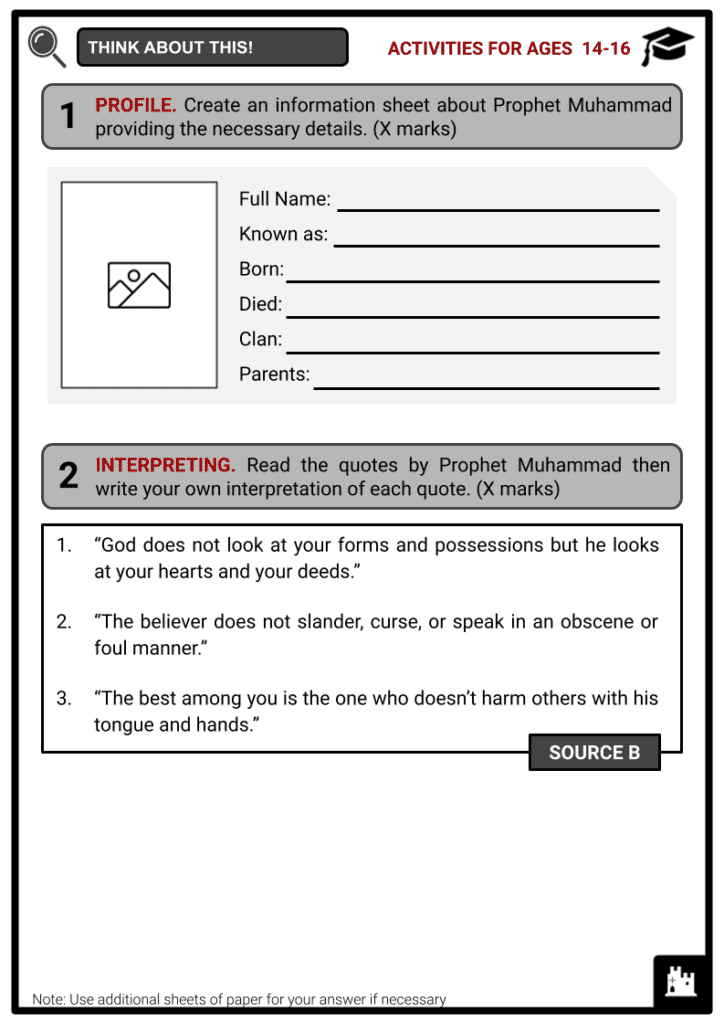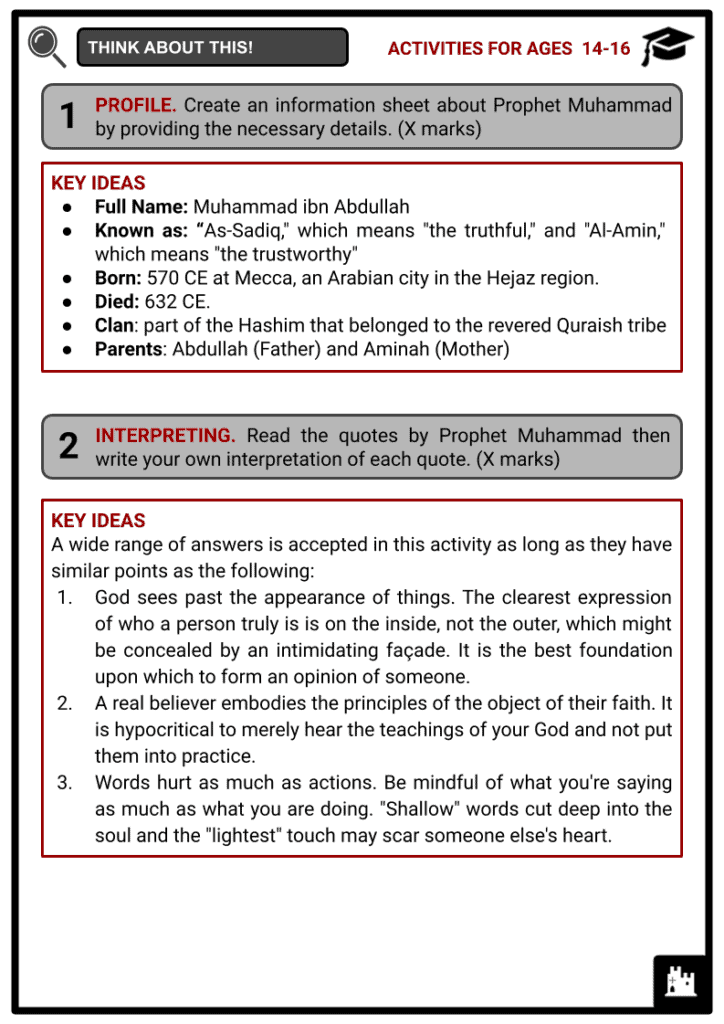Prophet Muhammad Worksheets
Do you want to save dozens of hours in time? Get your evenings and weekends back? Be able to teach about Prophet Muhammad to your students?
Our worksheet bundle includes a fact file and printable worksheets and student activities. Perfect for both the classroom and homeschooling!
Summary
- Early
- Prophethood and Preaching
- Battles Fought
- Death and Legacy
Key Facts And Information
Let’s find out more about Prophet Muhammad!
Prophet Muhammad, also known as Muhammad ibn Abdullah, was a major figure in Arab politics, culture, and religion. He also acted as the founder of the worldwide religion of Islam. He was a prophet who, in line with Islamic faith, proclaimed and defended the monotheistic teachings of Adam, Abraham, Moses, Jesus, and other prophets. Muhammad is honoured as the Prophets' Seal in Islam. The Quran, together with Muhammad's teachings and actions, served as the cornerstone of Islamic religious belief and helped to unite Arabia into a single Muslim government.
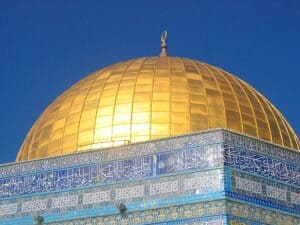
EARLY LIFE
- Muhammad was born around 570 CE at Mecca, an Arabian city in the Hejaz region. His clan, the Hashim, belonged to the revered Quraish tribe; at the time, it was led by his grandfather, Abd al Mutalib. The Hashim clan supplied water to Mecca pilgrims. Mecca, which is still revered by Muslims, was a holy site centred on the Ka'aba and home to a number of idols.
- Muhammad's father, Abdullah, had passed away while his mother was still pregnant, and his mother, Aminah, died in 576 CE when he was just 6 years old.
- He was thereafter raised by his grandfather, Abd al Mutalib, who passed away too two years later.
- After dedicating his life to raise Muhammad, Muhammad's uncle Abu Talib is observed to have loved Muhammad much like a father would.
- He developed into a trustworthy caravan dealer as he got older (rare in those days).
- He was known to the Arabs as "As-Sadiq," which means "the truthful," and "Al-Amin," which means "the trustworthy," and it is reported that many would entrust their wealth to him for safekeeping even after he started teaching a religion they did not believe in.
- A wealthy widow called Khadija sent Muhammad, then 25 years old, on a business journey with one of her commerce caravans. She was struck by his honesty and sent him a marriage proposal, which he accepted. It was agreed upon that Muhammad would not have another wife while he was married to his first wife in 595 CE, despite the fact that it was customary at the time to have more than one wife. His first wife was 15 years older than him but her support and company would aid him in his mission.
- The Prophet had two sons and four daughters from his marriage to Khadija, while Shia Muslims only recognise one daughter, Fatima. His two sons both passed away in infancy. Muhammad did have further wives later in his life, and he also had a second son, who also unfortunately passed away in infancy.
PROPHETHOOD AND TEACHING
- Muhammad started performing prayer in a cave called "Hira" in the mountain "Jabal al-Nour" meaning “Mountain of Light”, close to Mecca, as he approached his late thirties. The first revelation from God, "Allah," is said to have come to him one fateful day in 610 CE in the form of a light that purported to be the angel Gabriel. Muhammad reportedly felt confused and afraid at first and fled back to his house while trembling in terror. He didn't fully understand the duty that had been placed upon him until his wife consoled him and took him to see her cousin Warqa, a Christian scholar who recognised and informed him that he was a prophet.
- He started teaching the oneness of God to his loved ones and close associates; his wife Khadija became the first female conversion, while his personal friend Abu Bakr became the first male believer. After some time, in 613 CE, he started preaching openly, and the Meccans opposed him. At the Ka'aba, Mecca was home to numerous idols, and the majority of the city's economy depended on the pilgrims who came from all over the Arabian Peninsula to worship these idols, which Muhammad regarded as false deities. The Meccans tried everything to stop him, including physical torture and bribery. However, he refused to submit.
- Despite Muhammad's increasing power, competing Qurayshite clans boycotted the Hashim clan in an effort to persuade them to stop supporting him. This boycott made life for Muhammad and his followers — known to Muslims as the "Sahaba" — quite difficult, but it was eventually lifted.
- Muhammad switched his attention to Taif in 619 CE after experiencing constant rejection in Mecca. A chaotic mob of street youths threw rocks at him as he tried to flee the city after first being welcomed there but the people rejected his message. He barely survived the experience. According to a well-known Muslim belief, the angel Gabriel later went to Muhammad and asked him for permission to demolish the town. Muhammad declined, saying he was confident that they would eventually convert.
- His hope was wrecked by the passing of his uncle Abu Talib and his wife Khadija in 619 CE, which Muslims refer to as the "Year of Sorrow." Another of Muhammad's uncles, Abu Lahab, who disliked him, assumed Abu Talib's position, leaving Muhammad entirely vulnerable and without the help of his clan.
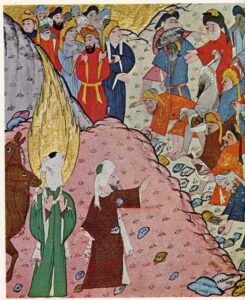
Abu Bakr and the Meccan Mobs - In 615 CE, some Muslims had already gone to Abyssinia (present-day Ethiopia), fed up with Meccan oppression. However, a true chance for the Prophet and the majority of his adherents to escape Meccan tyranny arrived in 621 CE when some residents of Yathrib (modern-day Medina) invited the Prophet to their city. They were moved by his message and desired the Prophet to govern them. Following orders, Muhammad and his companions moved to the city in groups.
- After barely escaping an attempt on his life, Muhammad and his close friend Abu Bakr left Mecca. In 622 CE, they arrived in Medina after a risky journey during which they were pursued by Meccans. Due to the significance of this exodus (hegira) in Islamic history, this is regarded as the year in the Islamic lunar calendar (AH) (After Hegira).
- Muhammad was no longer merely a preacher after assuming control of Medina; he was now a king. A powerful kingdom with norms of justice and cohesion never before seen in Arabia would soon emerge from Medina. Muhammad used a combination of persuasion and physical force to rewrite the law code and unify the city since betrayal was never forgiven by Arabs who lived by the code of retribution
- Al-Masjid an-Nabawi, a new centre of communal worship, was also founded by Muhammad (the Prophet’s mosque). Muhammad continued to preach as usual, but he now had two major advantages over his earlier life: political influence and a legion of loyal followers.
BATTLES FOUGHT
- The Muslims sought to avenge the damage of their previous oppressors, so they began raiding Meccan trade caravans from their new headquarters. As the Meccan economy deteriorated, they combined their forces to fight the Muslims. The Battle of Badr, which took place in 624 CE, saw the culmination of this when 313 Muslims, led to victory by their monarch Muhammad, defeated an army of 1,000 Meccans. Muslims perceived this as an act of favour on the part of God
- The Meccans' failure to respond to their defeat at Badr made them appear weak and vulnerable to their neighbours, which would have been disastrous for Arabia.
- The Arabs possessed a great sense of pride.
- Another sizable force was sent from Mecca the following year, in 625 CE, under the command of Abu Sufyan.
- He made the choice to drive the Muslims from Medina rather than laying siege to it. His troops set up camp close to the Mountain of Uhud, from where they started harassing their adversaries.
- This tactic was successful, and the Muslim army advanced to engage the enemy.
- The Muslims anticipated another victory despite being outnumbered once more.
- The Meccans evacuated their camps with all of their supplies after fleeing the field of combat, which initially went well for the Muslims.
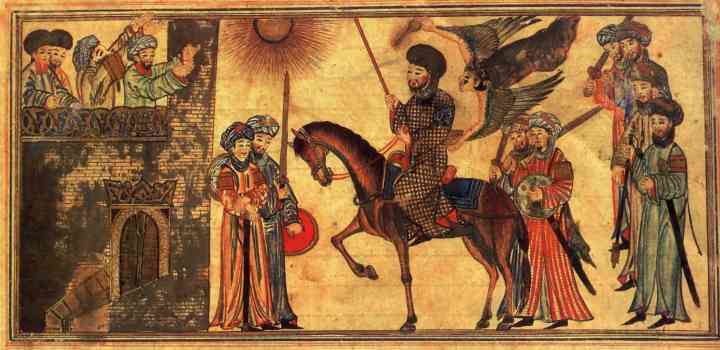
Banu Nadir - The rearguard abandoned its post to raid for war loot from the camps as the enemy fled and victory drew near (contrary to Muhammad's strict orders). The Meccans saw an opening in this and swiftly launched a surprise attack on the Muslims with their cavalry. Being caught off guard, the Muslims suffered terrible losses; Muhammad himself was hurt. The Meccans did not pursue the Muslims as they fled. They declared victory and went back to Mecca.
- Two years later, a confederacy posed an even larger threat to the Muslims.
- Banu Qaynuqa and Banu Nadir were two Jewish tribes that Muhammad had banished because, according to Islamic accounts, they had violated the Treaty of Medina, an agreement he had made with other Muslim rulers when he initially assumed the throne.
- These tribes marched toward Medina with the intention of laying siege to it, together with other Jewish tribes from Khaybar (an oasis close to Medina that served as a Jewish bastion in Arabia) and other minor Arabian tribes.
- The Muslims fortified the city with a trench to render the confederate cavalry ineffective; this method, which was new to the Arabs, gave the Muslims a significant tactical edge.
- Around 30 days were spent in Medina's siege, also known as the Battle of Trench in 627 CE.
- The confederates formed a secret alliance with Banu Qurayza, another Medinan Jewish tribe (which was neutral but was still bound by the Treaty of Medina), and their new strategy was to attack the Muslims from two fronts as the defenders and attackers lost patience as the days passed. When Muhammad knew of this, he sent warriors to defend both fronts. The Muslims would have been easily destroyed had the attacks occurred simultaneously, but the Prophet still had one card left to play.
- According to Islamic accounts, Muhammad instructed Nuaym ibn Masud, a respected Arab leader from the confederacy, to sow confusion between the confederate leaders and the Banu Qurayza. Nuaym ibn Masud was reportedly a covert Muslim. The invaders were forced to retire as a result of the lack of unity, strong defences constructed by the defenders, and deteriorating weather; the Muslims had won easily and with little loss of life.
- The Banu Qurayza tribe was then accused of betraying the community and upsetting the tranquilly. A harsh verdict was handed down by a Muslim judge and sanctioned by Muhammad, using a verse from the Torah as precedent: all men were put to death, women and children were slain alongside them, and all property was taken. This incident, known as the Massacre of Qurayza, has since inspired a never-ending discussion and debate. What is certain is that the Muslims' destiny would not have changed had the confederate conspiracy been successful.
- The Meccans forbade the Muslims from performing pilgrimage (Hajj) to the Ka'aba in 628 CE out of fear for their rising power. However, the matter was settled without conflict by the Treaty of Hudaybiyya, which granted the Muslims permission to perform pilgrimage the following year (which they did—a smaller version of it called umrah) and guaranteed safety for both the Meccans and the Muslims.
- In 628 CE, with the Meccans' dispute resolved, the Muslims advanced on the Jewish stronghold of Khaybar, whose citizens had sided with the Meccans two years earlier.
- The Muslims took possession of Khaybar, but the inhabitants were let to stay on their farms.
- Even after Muhammad's passing, the pattern of keeping local non-Muslims under Muslim rule would endure.
- While they did enjoy full religious independence, non-Muslims who lived in Muslim-controlled areas were regarded as dhimmi, or protected persons, and were required to pay a specific tax called the jizya (just as Muslims were required to pay zakat or charity).
- They would convert occasionally to elevate their social standing or out of genuine devotion, although forced conversions were also performed occasionally, despite Muhammad's clear instructions to his followers not to.
- The Meccans violated the Hudaybiyya Treaty within two years when they backed with one Arab tribe (Banu Bakr) against another (Banu Khuza'a), which was a Muslim ally.
- When the Muslim army arrived in Mecca in 630 CE, the city surrendered once the doors were unlocked.
- When Muhammad arrived in Mecca, he offered everyone amnesty in exchange for seeking refuge in the Ka'aba or Abu Sufyan's home (who had by that time accepted Islam).
- The Ka'aba was subsequently purified of all idols, at which point Muhammad proclaimed it to be the Islamic religion's holiest place.
- He would later make this his first and last full journey (the Hajj in 632 CE, which is also regarded as the farewell pilgrimage in Islamic history), as well as the location of his announcement that the divine revelation, the Quran, had been finished.
DEATH AND LEGACY
- Muhammad also sent forces to capture other significant areas of Arabia. At the battle of Hunayn in 630 CE, another confederacy (of Bedouins) was destroyed. In the year 631 CE, the city of Taif, from which he had been driven from his home, submitted to his dominion. The Muslim defeat in the Battle of Mu'tah in 629 CE ended an attempt to consolidate power over Arab tribes under to Byzantine rule, but it offered Muhammad's successors an idea for their future (successful) efforts against the Byzantines.
- Muhammad was the most powerful political figure in all of Arabia at the time of his death in 632 CE. The majority of the tribes had converted to Islam, albeit these conversions were typically motivated more by political than by spiritual reasons. After Muhammad's passing, this fact would become very important since these tribes would break away from the Islamic kingdom and need to be brought back under control. Following a brief illness, Muhammad passed away quietly in his home, surrounded by his youngest wife, Aisha (the daughter of Abu Bakr).
- Muhammad led armies with extraordinary skill and passion despite having no prior combat training. He had exceptional thinking and leadership abilities. Discovering that giving up his path would have resulted in benefits beyond his wildest expectations, as the Meccans had stated early on when they were trying to suppress him, he must have thought that his message was the wisdom that God had given to him.
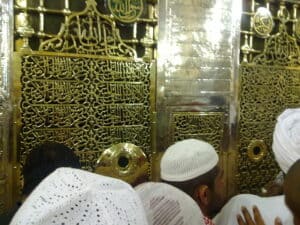
Muhammad’s Tomb - After the passing of his first wife, Muhammad married several times, as was common at the period.
- Muhammad treated his wives with the highest respect and love, even some of the marriages had been for the purpose of strengthen tribe ties.
- Although polygamy may seem unusual from a modern Western perspective, one should not criticise historical figures for adhering to social conventions at the time.
- Muhammad hasn't been forgotten despite the fact that he had no living sons (which was thought required for one to be remembered and for which he was harshly criticised in his day).
- Muhammad's name continues to be one of the most well-known Muslim names in the world. His message and the accessibility of Islam has made it the fastest-growing religion in the world.
- In stark contrast to Christianity, which heavily depicts Jesus and other biblical figures, Muslims think it is necessary that Muhammad not be represented in any images. This is because they associate such representations with the type of worship Muhammad opposed idolatry. One can understand Muhammad in his or her own way without having a physical representation of the Prophet, which enables a closer relationship with the religion's originator. As a mark of gratitude for all he gave up in his life to preach the religion of peace, Muslims now add "peace be upon him" to everything they hear, talk, read, or write about him.
Image Sources
- https://en.wikipedia.org/wiki/Muhammad#/media/File:Domeoftherock1.jpg
- https://en.wikipedia.org/wiki/Abu_Bakr#/media/File:Abu_Bakr_stops_Meccan_Mob.jpg
- https://en.wikipedia.org/wiki/Banu_Nadir#/media/File:Mohammed_receiving_the_submission_of_the_Banu_Nadir.jpg
- https://en.wikipedia.org/wiki/Muhammad#/media/File:Mrs_Aisha_room.jpg

